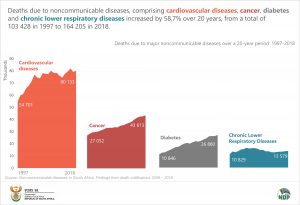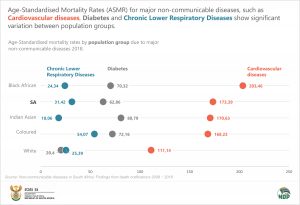Rising Non-Communicable Diseases: A Looming Health Crisis
Non-communicable diseases (NCDs) have emerged as a major global health challenge, affecting millions of individuals worldwide. A new report released by Statistics South Africa (Stats SA), Non-communicable diseases: Findings from death notifications (2008-2018), explores the changing landscape of NCDs in South Africa over time, highlighting key trends and insights.
Data from the World Health Organization (WHO) indicates a notable increase in NCDs like cardiovascular diseases, diabetes, respiratory diseases, and cancers. These diseases are major contributors to global morbidity and mortality. Factors such as urbanisation, sedentary lifestyles, unhealthy dietary habits, tobacco use, and rising obesity rates have contributed to this upsurge. Cardiovascular diseases, cancer, diabetes, and respiratory ailments constitute a significant portion of NCDs, presenting a growing public health challenge.1
In South Africa, deaths due to major non-communicable diseases (NCD) such as cardiovascular diseases, cancer, diabetes and chronic lower respiratory diseases increased by 58,7% over 20 years, from 103 428 in 1997 to 164 205 in 2018. The median age at death in years was 65 for males and 69 for females. According to the data, males had higher ASMR than females for all the non-communicable diseases.
The highest Age Standardised Mortality Rates (ASMR), or deaths per 100 000 persons, was observed for cardiovascular diseases, followed by cancer, diabetes and chronic lower respiratory diseases.
Deaths due to cardiovascular diseases (CVD) have steadily increased between 2008 to 2018, accounting for 12,9% in 2008, and increasing to 17,6% in 2018. Black Africans had the highest age-standardised mortality rates at 203.46 per 100 000, followed by Indian/Asian and Coloured population groups, at 170.63 and 168.23 per 100 000 respectively. The White population group had the lowest age-standardised mortality rates overall, at 111.14 per 100 000 in 2018.
In terms of persons with diabetes, racial differences in mortality may be a reflection of genetic predisposition to the disease, access to care, dietary or other behavioural practices that place one group of individuals at higher risk than others, or other factors.
The number of deaths due to diabetes increased by 36,5% (from 19 692 in 2008 to 26 880 in 2018). In 2018, the age-standardised mortality rate (ASMR) for diabetes was 62.86 deaths per 100 000 mid-year population. The Indian/Asian population group had the highest, but declining ASMR at 80.79 per 100 000, down from 94.13 per 100 000 in 2008, while the White population group had the lowest and steady ASMR at 20.4 deaths per 100 000. The Coloured and Black African population groups had lower but increasing age-standardised mortality rates than the Indian/Asian population group.
Chronic lower respiratory diseases accounted for 2,4% of all causes of mortality in 2008, and their contribution increased to 3% in 2018. Chronic obstructive pulmonary diseases (COPD) accounted for the majority at 62% (8 413), followed by asthma at 22,3% (3 023) and status asthmaticus at 5,4% (731). These leading chronic respiratory diseases accounted for almost 90% of all deaths due to chronic lower respiratory diseases. Males accounted for the majority of deaths at 60,2% (8 168) while females
Advancements in medical diagnosis and treatment have led to improved life expectancies. However, this has also resulted in a rise in the overall burden of NCDs on healthcare systems. The increasing number of people living with NCDs necessitates more extensive and efficient healthcare services, posing financial and organisational challenges for health systems.
Efforts to tackle NCDs have evolved over time, with a notable shift towards preventative strategies. Health education campaigns, policy interventions, and public health initiatives focusing on promoting a healthier lifestyle, early detection, and regular health check-ups have shown promise in curbing the spread and impact of NCDs.
In terms of burden of NCDs and mortality rates KwaZulu-Natal, Gauteng, Western Cape and Eastern Cape provinces have some of the highest number of deaths due to NCDs. This may be a reflection of their large populations as they host almost two-thirds of the population of South Africa. However, their age-standardised mortality rates are substantially different; this may be due to differences in access to health services or quality of the services provided. Free State has one of the lowest number of NCD-related deaths in absolute numbers, but some of the highest mortality rates.
In line with the World Health Assembly global strategy and the South African national strategic plan for the prevention and control of non-communicable diseases, recommendations for a comprehensive surveillance and monitoring system for NCDs needs to be implemented to establish baselines and monitor the 90-60-50 target cascade for non-communicable diseases.
The information in this report will enable the formulation of targeted interventions to address the increasing burden of non-communicable diseases, allocate resources appropriately, and implement health promotion programmes to create awareness about the risk factors associated with non-communicable diseases such as smoking, exposure to air and industrial pollutants that increase the risk of chronic respiratory diseases, physical inactivity, consumption of highly refined foods and saturated fats, harmful use of alcohol, and inadequate intake of vegetables and fruit. Regular screening for NCDs at health facilities needs to be reinforced to ensure timely diagnosis of these diseases and monitoring of patients to ensure that they are under control.
For more information on non-communicable diseases, download the full report here.
1https://www.who.int/news-room/fact-sheets/detail/noncommunicable-diseases



